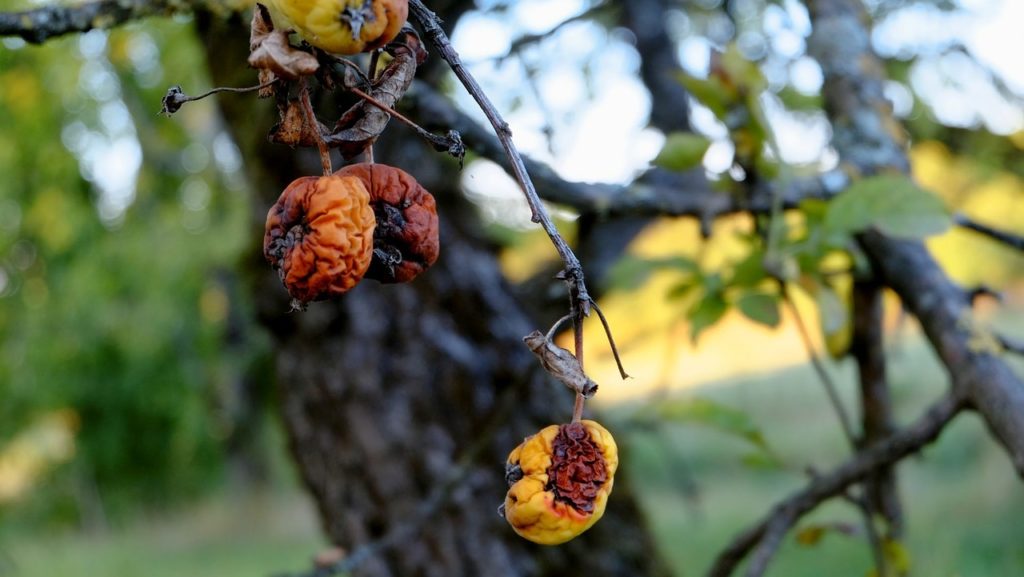Introduction
Black rot of apple, also called frogeye leaf spot, is a fungal disease that infects the fruit, leaves, and bark of various hardwood trees, including apple, pear, and quince. The disease is caused by the fungal pathogen Bostryosphaeria obtusa. The fungus is pathogenic on fruit trees. On most other hardwoods, the fungus is a secondary invader, or a saprophyte, colonizing and thriving on dead or weakened tissue. Black rot infections result in the formation of leaf spots and cankers on branches, while also causing fruit to degrade. On infected hosts, loss of fruit yield and extensive defoliation from leaf spot is common. Severe infections can reduce tree vigor, rendering hosts more susceptible to invasion from other disease pathogens and insects.
Distribution & Habitat
Black rot occurs across North America. It is especially common in warm, humid areas of the Central and Eastern United States, as well as southern Canada.
Hosts
Black rot primarily infects apple, cranberry, pear, and quince. As a secondary invader, black rot may infect alder, apricot, amelopsis, birch, bittersweet, catalpa, chestnut, cotoneaster, currant, dogwood, elder, hawthorn, hophornbean, lilac, linden, maple, mountain ash, mulberry, oak, peach, persimmon, rose, sassafras, sumac, tree of heaven, and witch hazel.
Disease Cycle
The fungus overwinters in black fruiting bodies called pycnidia and perithecia that have formed on dead bark, twigs, and mummified fruit. In spring, when conditions become sufficiently moist, the fruiting bodies release conidia and ascospores, which are disseminated by air currents or splashes of rain to nearby trees, where they initiate new infections. Conidia may continue to be produced throughout summer during wet periods.
The conidia and ascospores readily infect leaves, blossoms, fruit, and open wounds on twigs and branches. The conidia germinate in the susceptible tissue for five to six hours before becoming established. Additional infections may occur through injured wood and bark throughout the growing season. The black rot fungus is frequently observed in plant tissue that has been killed by fire blight, or is undergoing environmental stress.
Symptoms of Infection
Initial fruit infections occur during the bloom period. Symptoms of fruit infection will generally become apparent in midsummer, as the fruit matures. Decaying tissue with brown and black concentric rings may be observed on large sections of infected fruit. Some fruit will become desiccated, and remain attached to the tree. Occasionally, fruit will ripen prematurely, with the rotten tissue concentrated at the core.
Leaf infections develop as the bloom period concludes. Infected leaves will develop circular lesions with purplish or reddish outer borders, and light tan interiors. Cankers appear as sunken, reddish brown areas on infected branches and twigs. Cankered sections of the tree will often have rough or cracked bark.
Management
- Prune out and dispose of dead or diseased plant parts on susceptible trees. Administer pruning cuts at least fifteen inches beneath infected tissue. Infected plant parts can be burned, buried, or composted. Pruning should be performed during winter, when the fungus is inactive.
- Control fire blight by excising infected wood from plants.
- Maintain plant vigor by reducing stress from environmental conditions, and limiting insect infestations.
- Ensure that plants are sufficiently watered, especially during extended periods of drought.
- Apply a layer of organic mulch around the base of susceptible plants to improve soil quality, moderate soil temperature, and retain soil moisture.
- Remove the stumps of infected trees that are culled. Dead stumps may serve as overwintering sites for the disease pathogen.
- Fungicidal sprays may be utilized to prevent the infection of leaves and fruit. Initial applications should begin in early spring, during leaf expansion. Thoroughly drench the leaves and fruit to ensure efficacy. Susceptible branches may still be infected by the spores.


